While 99% of consumers might peek into their email inbox daily, getting them to actually engage with your emails is the real challenge.
In this guide, we’ll explore all about email engagement and share the must-do best practices for it. We will also discuss the challenges that come with driving engagement for your email campaigns and give you ideas on how to tackle them.
At the end of this guide, you’ll have the techniques to make your email marketing strategy more effective and get more engagement than ever before.
What Is Email Engagement?
Email engagement refers to how actively your target audience interacts with your email marketing messages. Your subscriber engagement reveals how effective your marketing efforts are at capturing attention and driving meaningful interactions.
So, what falls under “engagement” when it comes to your emails?
- Opening the email
- Clicking on links
- Replying to the email
- Converting or taking your desired action
To track all those, consider these email engagement metrics to measure your campaign’s effectiveness:
| Metrics | Target Results |
|---|---|
| High email open rates | 17% to 28% |
| Low unsubscribe rates | 0.2% or below |
| Click-to-open rate (CTOR) | 20% and 30% |
| Consistent conversion rates | 10% and above |
| Increased click-through rates | 3% (minimum) |
But remember, the numbers can change depending on your niche so make sure you or your email marketer team check your industry average.
6 Best Practices To Increase Email Engagement
As you read, check if you’re already doing the practical points. If yes, tweak it to better align with your brand’s goals. If not, brainstorm with your team on how you can quickly apply them to your email marketing campaigns.
1. Personalize Beyond The Name
Greeting your subscribers by name is good, but what can you do to take it to the next level?
Use your customer data to create truly personalized content that resonates with each person’s interests, behaviors, and needs. With a personal touch, your emails become more relevant, which naturally encourages subscribers to engage with your email program.
What To Do
Use dynamic content. For example, if you run an online store, show subscribers products based on their browsing history or past purchases. You can also send 1 type of email to frequent buyers and another to those who haven’t purchased in a while.
To do this, you can use HubSpot’s Smart Rules feature. It pulls in data from your CRM to create tailored product recommendations.
How to Use Smart Content in HubSpot Emails | HubSpot How To’s with Neighbourhood

Finally, use triggered emails—like sending a special offer to someone who just signed up. These emails are sent automatically based on specific actions or milestones in the buyer’s journey, making them highly relevant.
Plus, guide subscribers smoothly through the sales funnel. With this, you are delivering the right message at the right moment.
My favorite example of a triggered email is when I signed up for Shay & Blue, a women’s perfume brand. I instantly got a welcome email that included this:
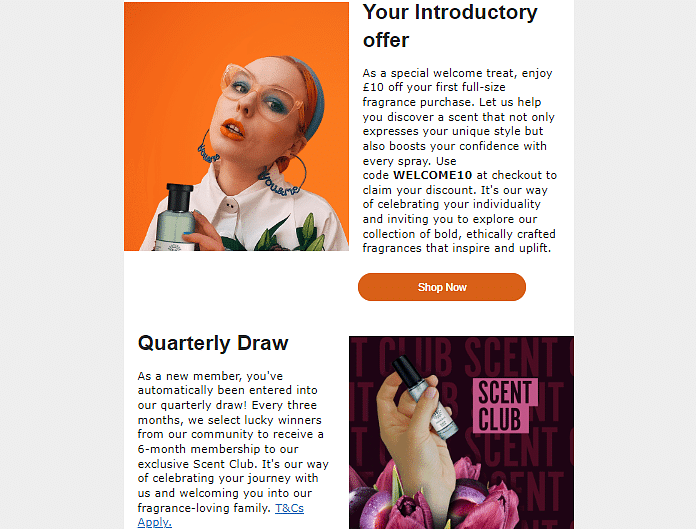
I got a discount and a chance to win a spot in their Scent Club community, which is the brand’s subscription-based service that offers exclusive perks. The raffle draw gives users something exciting to look forward to in future marketing emails. Plus, it’s a highly relevant offer to someone whose journey with the brand is only starting.
2. Ignite Action Vibrant Visual CTAs
CTRs for email CTAs generally hover around 3-5%.
To get that or push it higher, you need to add a twist to your CTAs. Your CTA shouldn’t just sit there; it should demand attention and compel your subscribers to act, whether it’s claiming discount codes or diving into your latest offer.
What To Do
First, design your CTAs with contrasting colors that pop against your email background—this draws the eye immediately. Next, add compelling images or videos that relate directly to your offer.
To help you put that together, use Hyperise’s image and video personalization tool. It lets you create visuals and interactive CTAs. For example, if your CTA involves offering rewards, you can do this:
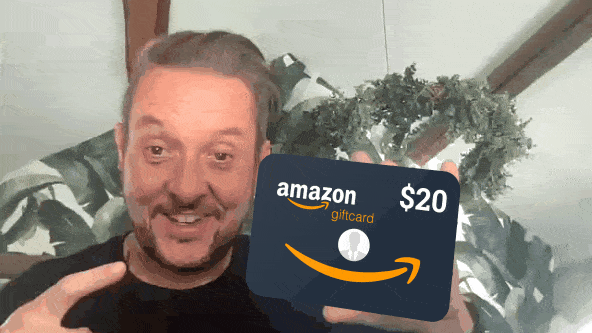
You can also do an area coverage type of prompt like this:

This graphic type is perfect if your business thrives on face-to-face interactions like real estate, industrial manufacturing, or financial services.
3. Build Buzz With Themed Campaigns
Create a series of emails centered around a specific topic, event, or season to keep your subscribers engaged over time. Themed email campaigns provide a sense of continuity and anticipation.
Use this to naturally encourage subscribers to be excited about what’s coming next. Since they’re staying tuned already, this gives you a higher chance to boost email engagement rates.
What To Do
Gather your marketing team and put these into your agenda:
Seasonal themes: Plan campaigns around holidays or seasonal changes. For example, send a series of emails leading up to a big winter sale. Each email can offer previews or exclusive discounts.
Event-based themes: If you’re launching a new product, build a series of teaser emails leading up to the launch. This keeps your subscribers engaged and eagerly awaiting the big reveal.
Customer-centric themes: Use survey respondents’ feedback to build a campaign focused on what your customers want. Tailor your emails to address their needs or interests to make each message more relevant.
4. Master The Art Of Click-Worthy Subject Lines
Craft email subject lines that grab attention and compel your subscribers to open your emails.
Why?
Because all your efforts in creating amazing content can go unnoticed if you don’t pull in people from the start. A good subject line acts as your tone-setter and makes that all-important first impression.
If you hook them in, it can dramatically increase your open rates, even among unengaged subscribers. With most marketers competing for attention, doing this right is your ticket to success.
What To Do
Keep it short and sweet—ideally, 5 to 7 words. Humans have an average 8-second attention span so short subject lines are more likely to catch their eye. Plus, this way, your subject lines stay intact when they check emails on mobile devices, so nothing important gets cut off.
In addition, you should create curiosity. Tease the content without giving everything away. For example, “Unlock the Key to Stress-Free Mornings” can pique interest since they’ll be curious about what you’re referring to.
Be clear and direct. If you’re offering a discount code or special deal, say it upfront: “Save 20% on Vitamin D Supplements Today!”
Lastly, pair a good email subject line with a strong greeting and opening line. This combination can make you hit a first-impression homerun. Here’s an example if you have a health and wellness brand:
Subject: “Unlock the Power of Berberine for Your Health”
- Greeting & Opening Line: Hi there, ever wondered how a simple supplement like berberine can transform your wellness routine?
Subject: “Your Guide to a Healthier You Starts Here”
- Greeting & Opening Line: Hello Wellness Warrior, we’re excited to share tips and products that’ll boost your journey to better health.
5. Bring Your Emails To Life With Interactive Features
Add elements that subscribers can actively engage with–quizzes, polls, or clickable images. With this, you can stand out in a crowded inbox and make your content more memorable. This can also encourage users to open your emails next time.
Plus, interactive features can make your emails feel like a two-way conversation. When subscribers love interacting with your content, they’re more likely to click through, share it on social media, and even convert.
What To Do
Include clickable images and let subscribers explore different parts of your email. To do this, choose an image and hyperlink it to a specific webpage, like a product page, blog post, or landing page.
In most email marketing platforms, like Constant Contact, you can do this by clicking on the image and then selecting the option to add a URL, like this:

Besides soaring engagement rates, clickable images can also direct more traffic to your website.
You should add polls or quizzes too. Use tools like Typeform to embed them directly into your email. Use this as a chance to also get valuable insights into your audience’s preferences.
But make sure your images, polls, and quizzes are relevant to your prospects’ goals to make your emails as effective as possible. For example, let’s say your prospects are interested in home design.
Include a clickable image of a beautifully styled living room that links to a guide on creating similar looks. You can also add a poll asking about their favorite interior styles, with personalized decor advice as the result.
Additionally, incorporate social sharing buttons. Make it easy for subscribers to share your content on social media to increase your reach beyond just the email list.
6. Present Tangible Value To Transform Interest Into Action
Offer clear, understandable benefits that show your subscribers exactly why they should care about your product or service. But go beyond listing features in 1-phrase bullet points. You should make those features relatable and valuable in your subscriber’s everyday life.
When you present tangible value, especially in re-engagement emails, you can reconnect with disengaged subscribers by showing them what they’ve been missing. It can give them a reason to re-engage with your emails, which will increase your click-through rate.
What To Do
Break down complex features if you have technical products since simply listing them might not cut it and cause a disconnect with your audience. For example, let’s say you’re selling car accessories like radar detectors.
You can create a blog post that dissects each of the radar detector’s features like this:
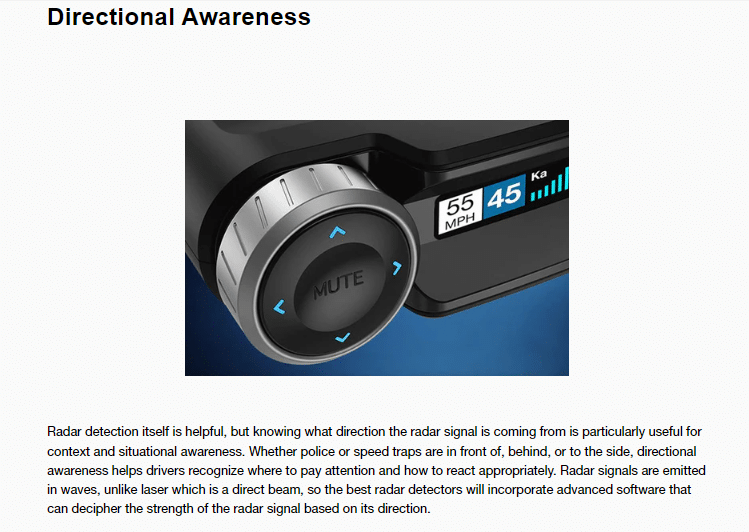
Of course, you can just link the blog post in your email. But why not go further?
Use Canva to create an infographic that highlights each feature. This way, it will be more engaging than just reading blocks of text.
In addition, relate features to real-world use and show how your product fits into your user’s life or business. For example, let’s say you’re promoting a schema for website breadcrumbs. Illustrate how this feature improves user navigation for your site with graphics like this:
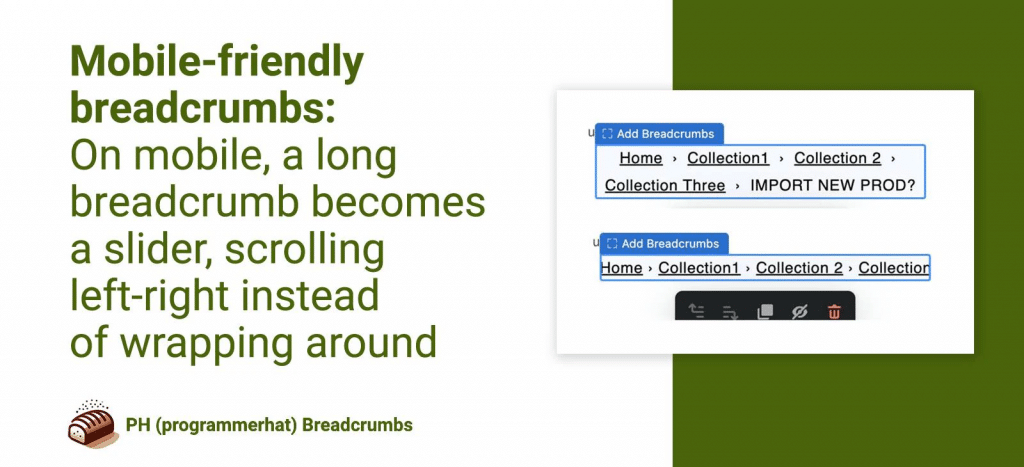
You can also show how easy it is to use:

With these tactics, you can convert your subscribers from readers to paying customers.
4 Common Email Engagement Challenges You Can Solve
Get ready to jot down 1 challenge that resonates with your experience, then note a specific solution to try next in your efforts to increase engagement.
A. Fight Against Spam Folder
When your emails get flagged as spam, all your efforts to reach your audience go to waste. This affects your open rates and it harms your reputation with email service providers, making it harder to get your future emails delivered.
So, how do you avoid the spam folder?
Use proper email headers, which are bits of information that help email service providers understand who the email is from and whether it’s trustworthy. You need to make sure your headers include accurate sender and receiver information.
Authenticate your emails by creating SPF records, setting up DKIM, and DMARC records.. You can set this up through your email platforms like Mailchimp:
Improve Email Deliverability: How to Authenticate Your Custom Domain (2024)

You should avoid spammy language too. Words like “free,” “act now,” or “limited time” in your subject lines or content can trigger spam filters. Be sure to stick to clear, honest language in your promotional emails to avoid being flagged.
B. Miss the Mark With Timing
If your emails land in your subscribers’ inboxes when they’re not checking, they will likely get ignored or buried under other messages. With this, your efforts in your next campaign won’t be as effective.
To solve this, consider time zones. For example, if you have a global audience, segment your list by time zone. This way, your emails arrive at the right time, no matter where your subscribers are located.
You can also look at your email marketing metrics like the open rate, to see when your subscribers are most active. So if you notice that your transactional emails perform best in the morning, continue to do that.
But that takes a lot of time. So look into how your chosen email platform can automate this process. For example, Mailchimp has the Send Time Optimization feature. It analyzes when your subscribers are most likely to engage. Then, it strategically times your emails to be sent during those peak moments.
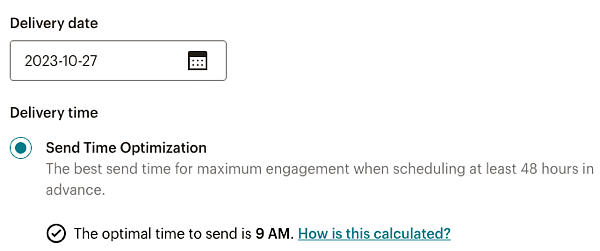
C. Struggle With Subscriber Loss
When people unsubscribe, it’s often a sign that your emails aren’t delivering the relevant and valuable content they’re looking for. With this, your marketing efforts take a big hit.
How do you solve this?
Segment your audience since not all subscribers are interested in the same things. You can do this through your CRM or email marketing tools like HubSpot:
List Segmentation For Marketers in HubSpot (Active Lists)

This way, you can send more targeted and relevant content that resonates with each group.
Another way to avoid this issue is to offer more value. Instead of bombarding subscribers with constant promotional offers, mix in educational content, advice from experts, or exclusive insights so they are more likely to stick around.
You should also ask for feedback. If you notice a trend of unsubscribes, send a quick survey asking why. This can help you adjust your approach and better meet your audience’s needs.
D. Confront Email Fatigue
Even with emails, customers can feel fatigued. When they get overwhelmed by the number of emails you’re constantly sending, they’re more likely to start ignoring it or even block your account.
But don’t worry, there’s always a fix.
You need to prioritize quality over quantity so focus on sending fewer, but more impactful emails. With this, your content will feel fresh and prevent your subscribers from feeling like they’re just getting more noise in their inbox.
Also, you can give your subscribers control over the types of emails they receive and how often. Add a preference center to your emails to let them choose what content is most relevant to them. You can also ask them upfront when they sign up for your email list.
Why Monitor Your Email Engagement?
So, why put in the effort to apply all these best practices and tackle the challenges? Why should you invest your time and resources into this?
Think of your email engagement as the pulse of your marketing efforts. If you’re not regularly checking it, you’re flying blind. You will miss out on crucial insights that can make or break your campaigns.
The thing with email engagement is that it isn’t just about the numbers. It lets you understand how your audience interacts with your brand on a deeper level. When this happens, you get to know what to give them so you can build trust and form stronger customer loyalty.
You can also use the data to spot trends to make better decisions and create a strategy that drives real results. It maximizes your ROI. Engagement data shows you where to focus your resources and make sure you’re not wasting time and money on ineffective tactics.
Conclusion
Now that you’ve got the lowdown on email engagement, it’s time to act. Review your recent campaigns—what’s working and where you are falling short. Then, get your team to brainstorm which best practices you need to prioritize right now.
Your next steps should be all about refining what you already have and making those small tweaks that can get you big results. But remember, this is not a 1-and-done deal. You need to continuously track your email engagement and adjust your tactics as needed.
So, are you ready to start improving your emails?
Here at Hyperise, we can help make your email marketing strategy a success. Our optimization tools can make your content fun, engaging, and conversion-friendly. Start your free trial now and enjoy the perks!
Author Bio:
Burkhard Berger is the founder of Novum™. He helps innovative B2B companies implement modern SEO strategies to scale their organic traffic to 1,000,000+ visitors per month. Curious about what your true traffic potential is?
- Author picture: Here
- Gravatar: vip@novumhq.com
Last Updated on September 24, 2024 by Ash